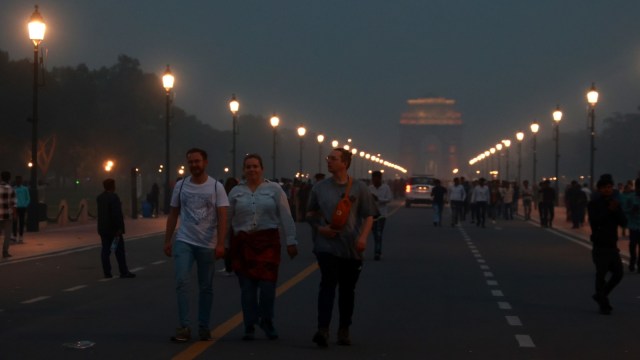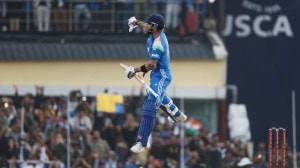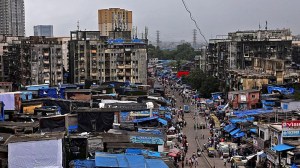Firecracker ban flouted, Delhi air quality worsens day after Diwali, triggers AAP-BJP blame game
Sharpest spike in post-Diwali AQI since 2015, set to deteriorate further
 Some of the city’s air quality monitoring stations recorded a spike in particulate matter levels from around 10 pm Sunday night. (Express photo by Amit Mehra)
Some of the city’s air quality monitoring stations recorded a spike in particulate matter levels from around 10 pm Sunday night. (Express photo by Amit Mehra) With the firecracker ban being flouted across the city on Sunday night, and the after-effect of the recent rainfall wearing off, Delhi’s Air Quality Index (AQI) deteriorated to 358 on Monday, worse than the post-Diwali AQI recorded last year.
This triggered a blame game between the AAP and BJP. While the AAP government accused the BJP of “instigating” people to flout the firecracker ban despite a Supreme Court order, the BJP accused the AAP government of failing to impose the ban.
Last year, the AQI on the day after Diwali, which was in October, was 303.
The deterioration in post-Diwali AQI this year was the steepest since 2015. On Sunday, the 24-hour average AQI was 218 (in the “poor” category) at 4 pm. On Monday, it deteriorated to 358 at 4 pm.
Since 2015, the post-Diwali AQI has seen a spike of over 100 points only once — in 2018, when it rose by 109 points as compared to the AQI on Diwali day.
According to the Delhi Pollution Control Committee (DPCC) data, the city’s average PM2.5 and PM10 levels were worse on Diwali day this year as compared to last year. The PM2.5 level was 314 µg/m3, a 45% increase from last year; the PM10 level was 430 µg/m3, a 33% increase from last year.
Some of the city’s air quality monitoring stations recorded a spike in PM levels from around 10 pm Sunday night. Hourly PM10 levels were 15 to 16 times the 24-hour standard at some stations Sunday night.
At the monitoring station at the Jawaharlal Nehru Stadium, for instance, the PM10 level peaked at 1632 µg/m3 at 2 am, when the 24-hour standard is 100 µg/m3. The level remained over 1000 µg/m3 from 11 pm to 4 am, falling to 467 µg/m3 by 8 am on Monday, according to data from the DPCC.
Similarly, hourly PM2.5 levels at the Jawaharlal Nehru Stadium were over 20 times the 24-hour standard on Sunday night and early Monday morning. The PM2.5 concentration peaked at 1423 µg/m3 at 2 am, when the 24-hour standard is 60 µg/m3. The level had fallen to 383 µg/m3 by 8 am.
However, post-Diwali AQI in the last two years is better as compared to 2015-2021, according to data from the Central Pollution Control Board (CPCB). The AQI was in the “severe” (401 to 500) category on the day after Diwali in 2016, 2017, 2020 and 2021.
A forecast issued by the Air Quality Early Warning System on Monday said the AQI is likely to deteriorate further and hit the “severe” category once again on Tuesday, and will remain “severe” till Thursday at least.
Rainfall on Friday, along with increased wind speeds, brought by a western disturbance, had helped break the “severe” air spell in Delhi — last Thursday was the seventh day this month when the AQI was “severe” (401 to 500).
“What had been washed away by the rain has now built up, and the impact of rain is fading away. After rainfall, winds get faster for a day or two, but that is now slowing down. Due to rainfall, there were no accumulated pollutants, which is why the AQI is better this year than it was in some of the previous years. A source of emission has been added… there is likely to have been a large contribution from firecrackers, along with others like transport emissions. The speed of transport level winds is not favourable for high intrusion of smoke from stubble burning,” said Gufran Beig, founder project director, SAFAR, and chair professor, National Institute of Advanced Studies.
After remaining high under the influence of the western disturbance till Saturday, wind speed began slowing down on Sunday, according to Kuldeep Srivastava, scientist, India Meteorological Department (IMD).
Sachchida Nand Tripathi, Professor at IIT-Kanpur and Member, Steering Committee, National Clean Air Programme, said: “The spike can partly be attributed to firecracker emissions. This is like a large source (of pollutants) coming in for a very short period of time. Since so many point sources have been created due to firecrackers, some contribution will be there, but for a day or two. There are calm conditions and other sources of pollutants as well which are already at play, and none of these sources have gone away.”
Dipankar Saha, former head of the CPCB Air Laboratory, said: “A ban on firecrackers is imposed to prevent addition of emissions. The violation cannot be justified in any way. Pre-Diwali rainfall resulted in improvement of air quality, but deterioration has begun again with meteorological conditions allowing accumulation of pollutants.”
Meanwhile, addressing a press conference, Delhi Environment Minister Gopal Rai accused BJP-ruled states and party leaders of “instigating” people to burst firecrackers in a “targeted manner”.
“I congratulate those people of Delhi who followed the order of the Supreme Court and did not burst firecrackers as a matter of humanity. BJP leaders kept instigating (people) to burn firecrackers,” Rai said.
“If the BJP had banned firecrackers in UP and Haryana after the Supreme Court’s order, pollution would not have increased in NCR… Supply of so many firecrackers is not the work of a common man, this has been done on a large scale under the patronage of the UP and Haryana governments,” he alleged.
Hitting back, BJP’s Badarpur MLA and Leader of the Opposition in the Delhi Assembly, Ramvir Singh Bidhuri, accused the AAP government of having failed to effectively impose the ban.
“The notification for the ban was deliberately issued late… Therefore, Arvind Kejriwal himself should present his failure in imposing the ban before the Supreme Court and apologise for the unsuccessful attempt,” Bidhuri said.
“The Delhi government announced a ban on bursting crackers on Diwali on September 12… but the notification for the ban on crackers was intentionally not issued promptly… This notification was issued almost a month later, on October 6… Firecracker shops in Delhi remained open… people stocked up, and the stock was used on Diwali,” he said.







